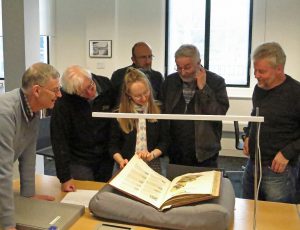April 22, 2016
History Group Visit to the RMG Caird Library
Report by: Mike Dryland
A party from the History Group enjoyed a visit to the RMG Caird Library to look at a selection of rare and interesting books from the astronomy collection. The visit was hosted by Gareth Bellis and Stawell Heard of the library staff, and by Louise Devoy, Curator of the ROG.
The books were divided into three sections and Louise gave a short overview of each (see list below) before we were invited to browse while Louise gave more details and answered questions.
“Early milestones” included the classic works from Apianus, Copernicus, Kepler, and Newton.
“Development of the observatory” illustrated the growing sophistication of astronomy starting with Flamsteed’s achievements and including a selection of manuscript letters from Nevil Maskelyne (fifth Astronomer Royal) and George Airy (seventh). The section concluded with William Huggins classic of stellar spectra, marking the birth of modern astrophysics, and Walter Maunder’s report on the BAA expeditions to observe the total solar eclipse of 1900. The BAA report marked the growth of popular interest in astronomy.
“Popularising astronomy” – improving standards of education in the Victorian era boosted a huge increase in public interest, and this section included popular works from George Airy (1849) and up to Arthur Eddington (1927).
Visitors were very interested in all the books on display and inspired by many, but the star of the show was Peter Apian’s “Astronomicum Caesareum” from 1540. This is a stunningly beautiful book, lavishly illustrated and includes more than 30 ‘volvelle’ – exquisite and complex paper dials which can be turned and set to illustrate the ideas in the text and find planetary positions etc. It pre-dates Copernicus and reflects the Ptolemaic geocentric system probably using the Alphonsine Tables. The Caird’s copy is in splendid condition and the work is all the more impressive when we remember it was printed in the time of “Wolf Hall” – King Henry VIII was on the throne of England. In fact one of the ‘Caesars’ in the title was Holy Roman Emperor Charles V who was nephew of Katherine of Aragon, Henry’s first wife. A breath-taking book indeed.
Many thanks to Louise, Stawell, and Gareth for a thrilling visit.
– – – – –
Early Milestones:
- Peter Apian “Astronomicum Caesarium” 1540
- Nicholas Copernicus “De Revolutionibus” 1543
- Johannes Kepler & Tycho Brahe “Tabulae Rudolphinae” 1627
- Isaac Newton “Principia Mathematica” 1687
Development of the Observatory:
- John Flamsteed “Historia Coelestis” The ‘Pirate Catalogue’ 1712
- John Flamsteed “Atlas Coelestis” 1729
- James Bradley “Greenwich Observations 1750-1762” 1798
- Nevil Maskelyne correspondence with Pigott
- George Airy miscellaneous letters c. 1847
- William Huggins and Margaret Huggins “An Atlas of representative solar spectra..” 1899
- E. Walter Maunder “The total solar eclipse 1900..” 1901
Popularising Astronomy:
- George Airy “Six lectures on astronomy..” 1849
- Robert Ball “The story of the heavens” 1890
- Edwin Dunkin “The Midnight Sky” 1891
- E. Walter Maunder “The Royal Observatory Greenwich..” 1900
- Arthur Eddington “Stars and Atoms” 1927
Note and links to each book we viewed:
Pictures from the Trip (by Mike Dryland):
Posted under: Flamsteed, History of Astronomy, Meeting Report, Society Trip











You must be logged in to post a comment.